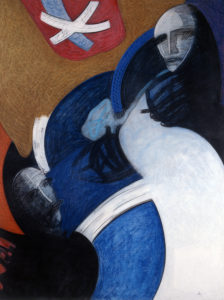16 Fév Fritz BILLETER – Under The Sign Of The Mask, 1994
Fritz BILLETER
Under The Sign Of The Mask
Since 1978 Philippe Grosclaude has been using pastels, having previously worked in oils and acrylic. The mention of pastels inevitably conjures up flowery hues, the charms of Renoir or the powdery shimmer of the rococo. It is perhaps no coincidence that it was a woman, the Venetian artist Rosalba Carriera (1675–1757), who brought the pastel technique out of the relative obscurity of its supporting role. Philippe Grosclaude’s pastel works, by contrast, are neither soft nor airy, but « masculine ». So why take up pastel crayons if you have no intention of exploring their characteristic possibilities? One reason is that Grosclaude’s pictures are created by applying successive layers of colour – sometimes as many as forty. Working in oils, he would have to wait for each layer of colour to dry; with acrylic it would be quicker – but not quick enough for Grosclaude. With pastels, on the other hand, he can apply layer after layer without stopping. (On a technical note, it is interesting that he spreads a layer of grease crayon between each layer of pastel to give the pigment powder a more adhesive substrate.) This continuity in the process of creating the picture is important to Grosclaude. There are artists, such as Leonardo da Vinci, who spend longer in front of their pictures thinking than actually working on them. There are artists who work on four or five pictures at once, who can switch without difficulty from one to another. Not so Philippe Grosclaude: he can only concentrate on one painting at a time; and that is why, if at all possible, he wants to be able to finish it in one go. The fact that he can only concentrate on one picture at a time means he always has just one thing in mind: his vision. The word seems almost antiquated and pompous in today’s post-post-modern world. On the other hand, I cannot imagine that the dilly-dally approach prevailing today (comme ci comme ça) will last for long. The coming trend could take us where Grosclaude has been from the very start: a tragic position. But how can Grosclaude’s vision be put into words; how can we describe one of his typical pictures.
In Grosclaude’s work, abstract forms are piled, in interlocking structures, layer upon layer, permeating one another in thrust and counterthrust: in rounded, elliptical, parabolic, trapezoid and spindle-shaped forms which are rarely closed and often stretch beyond the edge of the picture. Asserting themselves alongside such expressive geometry are freehand gestures, scratchings, bundled lines – albeit this « tachiste » tendency is tamed, has to hold itself in check. The colour climate is seldom cosmically icy; but a chill wind does blow at you: blue, blue-green, white and black. But this inhospitable quality is countered by warm earth colours which can reach an intensive orange. There are two outstanding motifs in what I have described as Grosclaude’s highly expressive geometry: the mask and the star. It is not that the faces Grosclaude often shows in half profile are wearing masks, but that the faces themselves are frozen into masks. They are petrified in heroic forebearance, in sorrow and pain, perhaps in composure. Grosclaude has fashioned his own set of conventions out of the features of these faces: full, heavy mouths; large, slightly crooked noses, with the bridges somewhat overemphasized so that they catch the light, while the eyes are shrouded in darkness. The head is covered by a cowl or hood, or heavily flowing hair. To the extent that Grosclaude’s faces are always based on the same Mediterranean-male archetype, they can be described as iconic. They can appear to radiate an inner light, have the pallor of a plaster death mask, appear empty, as though extinguished, or almost swallowed by a surge of ambient colour. Grosclaude’s star, a figure with four to seven points, is sometimes set on the mask-like face. More often, it is nearby; and at times appears separately in its own right. Like the face, this symbol is a variation on an archetype. One is reminded a little of the conventions of the comic strip; which would mean a touch of humour could be detected in Grosclaude’s work. May we describe this star as a symbol? And if so, what does it represent? The artist himself says that, on the whole, his paintings always express something akin to an explosion or implosion. His star represents the forces bursting forth as well as those compacted in the inward collapse. In my view, Grosclaude’s star is not there to guide the errant on their path through life, but rather to remind us that our lives are governed by blind fate.
Fritz Billeter, Under The Sign Of The Mask, 1994
In monograph : « Pour un autre regard », Françoise Jaunin, ABC-Verlag, Zurich 1994
